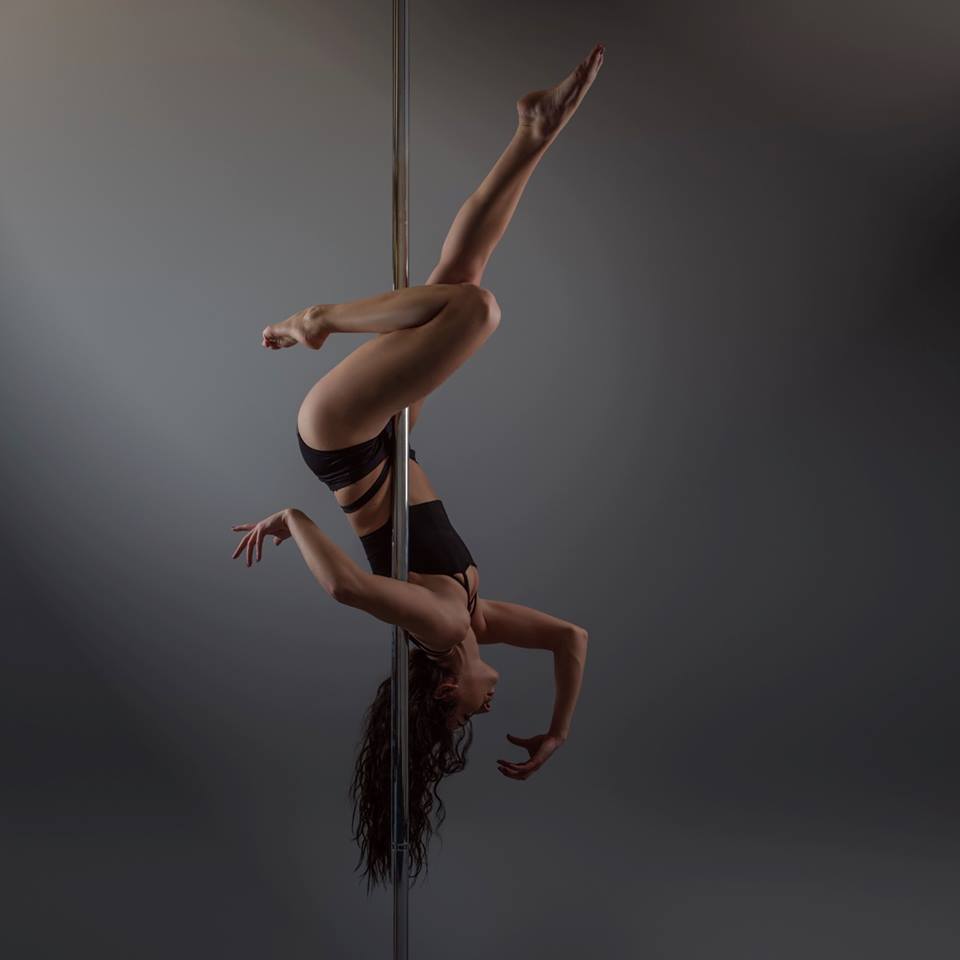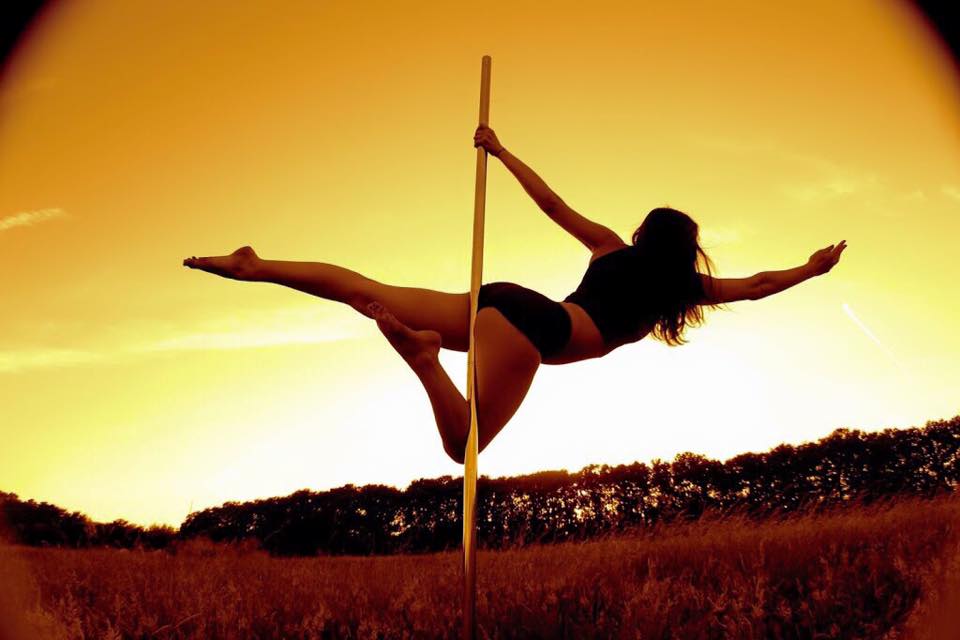Ever thought about trying out pole dancing? KU’s Stephanie Johnson talks about how the sport helps her build confidence and self-esteem.
Empowerment might not be the first word that pops up into your head when you think about pole dancing. But how much do you really know about pole dancing?
Your perception is clear: a dirty bar, a couple of unhappily married or newly separated middle-aged men with too much belly fat and an intense gaze fixed at a pair of long, bare legs.
You are probably also thinking: “Poor women!” and “It is not their fault. They have no other choice.”
But what about when they do have a choice, and they choose to do it?
Stephanie Johnson is not a pole dancer by profession. She is an ordinary woman with an MA in policy and education who works in Kingston University’s Student Union as a representation coordinator, currently organising the student elections. She is far from oppressed or out of choices. However, pole dancing is the main passion in her life.
“I want to say that pole dancing is about feminism,” Stephanie says. “Just in terms of equality for all. It’s welcoming to all people. It’s not just for women, it’s for guys as well.”
Although guys in pole dancing are not usually spoken about as much, it is not as rare as you may think. Stephanie practices pole dancing at the same studio as the world champion Sam King and adds that she regularly attends “heels classes” at the London Dance Academy. The class is led by a man. He is, of course, also wearing heels – in case there was any doubt.
“There’s so many different types of people and it doesn’t matter, everyone empowers each other and it’s a celebration of different sizes and shapes. It’s not about how you look, it’s about what you can do.”

Stephanie says that she has personally never experienced any resistance when talking about her rather extraordinary hobby, but acknowledges the stigma that pole dancers are faced with. She makes me aware of the hashtag #ILikeTheStigma, a hashtag created by pole dancers to retain control over the stereotypical image most people have of them. Type it into your search-bar on Instagram and you will discover a constant flow of pictures of pole dancers pushing posts to make people aware of their pride connected to the activity.
“I like the stigma,” Stephanie says. “If people have problems with pole dancing it just shows how backwards they are thinking.”
In March, Stephanie will attend her first ever competition. Yes – pole dancing is also a sport. In fact, the International Federation of Pole Sport is currently campaigning for “poling” to be included as a sport in the Olympics by 2020.
“It really annoys me when people say it’s not a sport. It definitely is a sport. It is a sport and it is a skill. That’s the one thing that really pisses me off, actually,” Stephanie says.
However, she is clear about not wanting to make a distinction between pole dancing and the seemingly more respectable pole sport.
“When people come to me and say I do pole fitness, I’m like ‘no, I’m a pole dancer’ because I don’t think there should be a difference and it’s the same thing.
“There’s nothing wrong with pole dancers in the same way as there is nothing wrong with people who do it for fitness,” she says and adds that this is a broader discussion within the pole dancing community.
Stephanie also tells me that strippers and pole dancers have become a huge part of the feminism movement in New York, inspired by fierce and empowered women such as Jacq the Stripper, who brands herself as feminist and makes comics and merchandise to provide a perspective on the actual experience of being a stripper. She has also written a book with the title: “How to not be a dick in a strip club: a patron’s guide.”
Increased attention is also raised around the issue of the lack of rights and tolerable conditions for the women (and men!) choosing to work and live as strippers, an issue Stephanie is very passionate about.
“It’s precarious work, the conditions aren’t great, but this is someone’s job. Why is that not regulated?” Stephanie asks.
Although she is not in the profession herself, Stephanie has a lot of good friends who are strippers and says she learns pole dancing tricks from them all the time.
“It’s about free choice and I think the same thing about sex work,” she says. “Work is work. I believe that people should have the same rights and strippers are people. Everyone should respect that.”
The problem is clearly the lack of respect for those working in the profession rather than the profession itself. In addition to attending pole dancing classes in London four to five times per week and additional exercises at the pole in her own living room every weekend, Stephanie also works part-time in a bar. Behind the counter. Serving beverages.
“I find it hard enough dealing with misogynistic clientele as it is without having to dance for them, I’d probably end up sacked,” she says when I ask her if she would ever consider working as a pole dancer.
Stephanie describes being asked to have sex for money and a customer who put his hand up her leg while she collected glasses. On another occassion, Stephanie was told that she was an “ugly aggressive bitch anyway” after rejecting a request. These stories might not seem too unfamiliar for anyone who has worked as a bartender.
“I can only imagine the shit that the girls who work in [strip clubs] have to put up with and I take my hat off to them for managing that.”
If the reality of strip clubs weren’t so dark, the outlook of pole dancers might have been brighter.
“If the job was to do pole routines for the entire night and nothing more while making a decent amount of money, then sure. I’d rather do that than serving customers from behind a bar! I wouldn’t have to speak to anyone and get to dance all night, what could be better?” she asks.
Stephanie first started to attend pole dancing classes after watching famous pole dancer Kitty Velour doing acrobatic movements in an aerial hoop at an event in London three years ago.
“I saw her dancing and I was like ‘oh I want to do that” and that’s when it all started,” Stephanie says.
Pole dancing has helped Stephanie build confidence as well as physical and mental strength. It has also helped her cope with her anxiety and everyday struggles.
“It’s the one thing that would bring me back to reality. Exercise is good for depression and all kind of mental health issues. When I’m having a shit day and I go and dance, I leave with a clear head.
“I just feel fresh. I would recommend anyone who’s got any kind of issues to try it,” she says.

Now she wants to start a pole dancing society and build a new community at Kingston University. For that, she needs 10 students to sign up before putting forward a request to the Student Union staff.
“It’s up and coming, a lot of other unions in the country are competing with each other in pole,” she says.
“It would be really cool if we could put a team together, or just anyone who wants to do it. Let’s twerk!” she says laughing.
Stephanie talks about the obsession with the so-called “pleasers” – the extremely high heels most pole dancers use – and explains it is a fetish.
“I know pole dancers with 50 pairs of heels and there’s a competition of how high can you go,” she says while laughing. The heels she is competing in are eight inches tall.
“Some people find them quite intimidating, like my boyfriend. He does not like it, but I just tell him to piss off,” she jokes. “He sees them and he’s like ‘they look scary’.”
She adds that he is generally supportive of her hobby. “Otherwise I would have ended it in the early days,” she assures me.
“I wonder if he finds them embarrassing because I’m so much taller than him when I put them on!”
So what is the best part about pole dancing? Stephanie struggles to choose only one aspect, but finally says that the reason she keeps coming back is the fact she sees progression so quickly.
“What keeps me there is how much of a real challenge it is. But when you progress, you really can see it.”
From India to Las Vegas: A snapshot of pole dancing history short history of pole dancing
Pole dancing and pole sport has a much longer history than many people might assume.
The earliest recorded case is the Indian pole sport mallakhamb – a sport originally practised by male wrestlers – which dates back to 1135 AD, but became increasingly popular throughout the 18th
century.
Mallakhamb is a sport which is practised on a wooden pole. “Malla” comes from the literal translation meaning “wrestler” and “khamb” which means “of pole”.
It is still popular today and is often performed by more than one dancer, using poles and ropes to perform aerial yoga positions.
The Chinese pole tradition dates back to the 12th Century and mainly involved circus professionals who climbed 10-30 feet tall poles before sliding down, holding different poses.
During the American depression in the 1920s, exotic dance movements featured in performances by a group of dancers called ‘hoochie coochies’ who put on shows for crowds in tents, using the pole holding the tent in place to perform sensual movements.
The first modern type of pole dance was in 1968. Throughout the 80s strip clubs in Canada and the US it became increasingly popular before spreading across to Europe and other parts of the world during the 90s.
The most prominent contributor to pole dancing as we know it today is arguably the Canadian-born Fawnia Dietrich who was the first to introduce a pole dancing lesson in 1994. She produced a DVD that inspired thousands of women worldwide to learn pole dancing without leaving their living room.
Dietrich later started the first-ever pole dancing school and from 2000 onwards, pole dancing has marked itself as a sport and popular way of getting fit, with more and more competitions taking place.
The first World Pole Sports Championships took place in 2012.
The International Pole Sports Federation is currently carrying out a campaign to include pole sports in the Olympics by 2020.


I’d like to find out more? I’d love to find out more details.